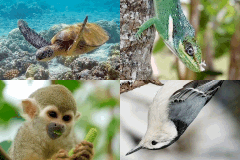 AnAge entry for Caenorhabditis elegans
AnAge entry for Caenorhabditis elegans
Classification (HAGRID: 04237)
- Taxonomy
-
Kingdom: Animalia
Phylum: Nematoda (Taxon entry)
Class: Chromadorea
Order: Rhabditida
Family: Rhabditidae
Genus: Caenorhabditis
- Species
- Caenorhabditis elegans
- Common name
- Roundworm
Lifespan, ageing, and relevant traits
- IMR
- 2/year
- MRDT
- 0.04 years
- Maximum longevity
- 0.16 years (captivity)
- Source
- Multiple references, please see bibliography below
- Sample size
- Large
- Data quality
- Acceptable
- Observations
These animals are free-living nematodes usually found in the soil of temperate environments. After hatching, roundworms undergo four larval stages before reaching adulthood. Caloric restriction has been shown to extend lifespan in roundworms. Temperature also influences the lifespan of the roundworm with higher temperatures shortening lifespan and lower temperatures extending lifespan, at least until a certain threshold [0745]. Although physiological ageing has been described in roundworms, in particular at the level of decreased movement which may reflect a decline in muscle cells, the cause of death of old animals remains a mystery [0981].
Several genetic manipulations have succeeded in extending the longevity of the roundworm, but many of these take into account the dauer stage, which involves a developmental arrest [0592]. As such, the maximum longevity is a conservative estimate.
Life history traits (averages)
- No information is available on life history. Please contact us if you wish to suggest or contribute data.
Metabolism
No information on metabolism is available.
Species in other databases
References
- [1279] Zhao et al. (2017), Two forms of death in ageing Caenorhabditis elegans (PubMed)
- [1242] Marck et al. (2017), Age-Related Changes in Locomotor Performance Reveal a Similar Pattern for Caenorhabditis elegans, Mus domesticus, Canis familiaris, Equus caballus, and Homo sapiens (PubMed)
- [1150] Jones et al. (2014), Diversity of ageing across the tree of life (PubMed)
- [0981] Wolf and Austad (2010), Introduction: Lifespans and Pathologies Present at Death in Laboratory Animals
- [0982] Sutphin and Kaeberlein (2008), Dietary restriction by bacterial deprivation increases life span in wild-derived nematodes (PubMed)
- [0273] Huang et al. (2004), Measurements of age-related changes of physiological processes that predict lifespan of Caenorhabditis elegans (PubMed)
- [0274] McCarroll et al. (2004), Comparing genomic expression patterns across species identifies shared transcriptional profile in aging (PubMed)
- [0067] Johnson (2003), Advantages and disadvantages of Caenorhabditis elegans for aging research (PubMed)
- [0275] Hertweck et al. (2003), C. elegans, a model for aging with high-throughput capacity (PubMed)
- [0276] Lund et al. (2002), Transcriptional profile of aging in C. elegans (PubMed)
- [0016] Johnson (2002), A personal retrospective on the genetics of aging (PubMed)
- [0337] Tissenbaum and Guarente (2002), Model organisms as a guide to mammalian aging (PubMed)
- [0066] Gershon and Gershon (2002), Caenorhabditis elegans--a paradigm for aging research: advantages and limitations (PubMed)
- [0277] Braeckman et al. (2001), Insulin-like signaling, metabolism, stress resistance and aging in Caenorhabditis elegans (PubMed)
- [0053] Guarente and Kenyon (2000), Genetic pathways that regulate ageing in model organisms (PubMed)
- [0069] Gershon and Gershon (2000), Paradigms in aging research: a critical review and assessment (PubMed)
- [0714] Van Voorhies and Ward (1999), Genetic and environmental conditions that increase longevity in Caenorhabditis elegans decrease metabolic rate (PubMed)
- [0278] Ailion et al. (1999), Neurosecretory control of aging in Caenorhabditis elegans (PubMed)
- [0052] Lithgow (1996), Invertebrate gerontology: the age mutations of Caenorhabditis elegans (PubMed)
- [0279] Fabian and Johnson (1995), Identification genes that are differentially expressed during aging in Caenorhabditis elegans (PubMed)
- [0280] Johnson (1990), Increased life-span of age-1 mutants in Caenorhabditis elegans and lower Gompertz rate of aging (PubMed)
- [0002] Caleb Finch (1990), Longevity, Senescence, and the Genome
- [0281] Johnson (1987), Aging can be genetically dissected into component processes using long-lived lines of Caenorhabditis elegans (PubMed)
- [0745] Klass (1977), Aging in the nematode Caenorhabditis elegans: major biological and environmental factors influencing life span (PubMed)
- [0592] Klass and Hirsh (1976), Non-ageing developmental variant of Caenorhabditis elegans (PubMed)
- [0046] WormBase
External Resources
- Integrated Taxonomic Information System
- ITIS 63332
- Animal Diversity Web
- ADW account
- Encyclopaedia of Life
- Search EOL
- NCBI Taxonomy
- Taxonomy ID 6239
- Entrez
- Search all databases
- Ageing Literature
- Search Google Scholar or Search PubMed
- Images
- Google Image search
- Internet
- Search Google

